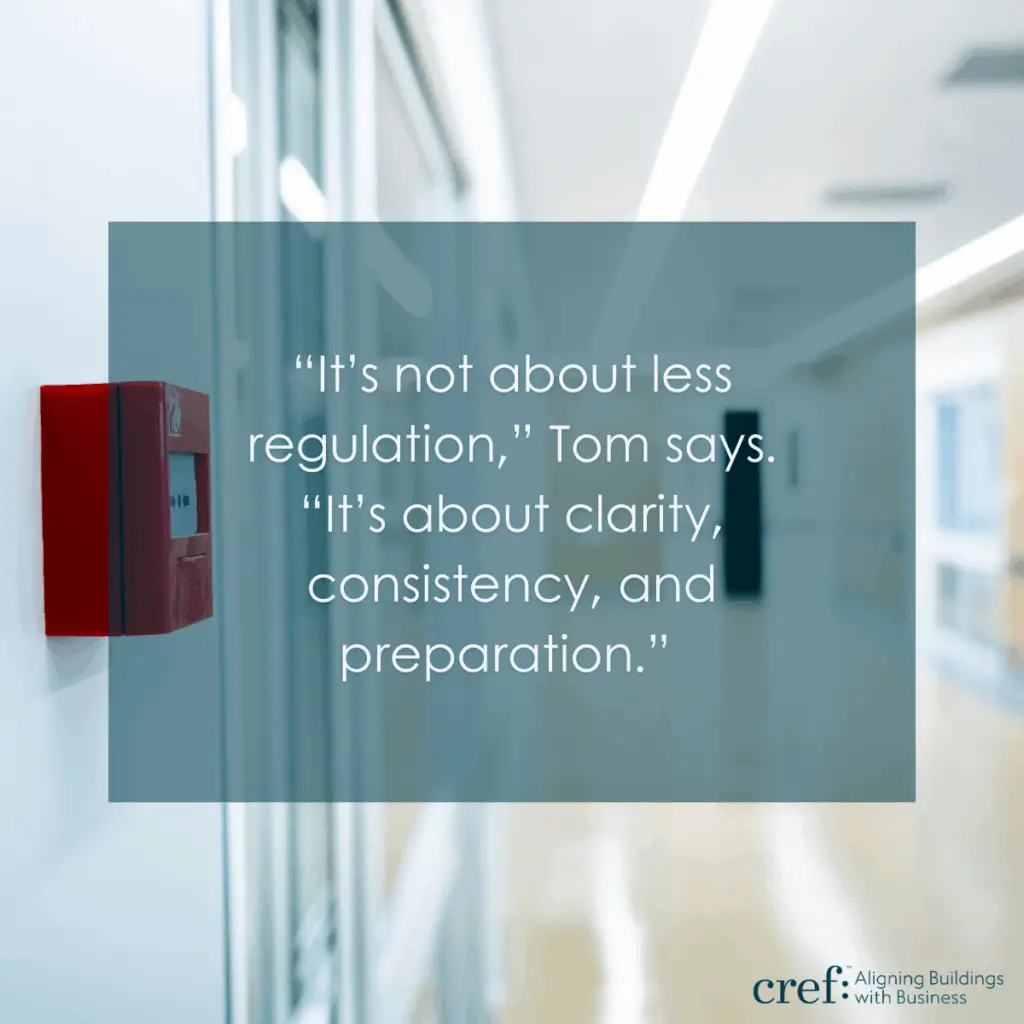When The Joint Commission announced its new Accreditation 360 program, effective January 1, 2026, the healthcare industry took notice. For professionals in healthcare facilities management, the change signals more than just new terminology, it represents a transformation in how hospitals approach Life Safety, Environment of Care, and long-term regulatory readiness.
Tom Grice, Vice President of Regulatory & Facilities at CREF, believes Accreditation 360 is a positive step toward alignment and clarity in the accreditation process.
“It’s not about less regulation,” Tom says. “It’s about clarity, consistency, and preparation.”
A Move Toward Alignment and Clarity
For years, facility leaders have navigated overlapping standards from CMS, Joint Commission, and other accrediting bodies. Accreditation 360 was designed to reduce redundancy, eliminate confusion, and help hospitals maintain a constant state of readiness.
“The practical implication,” Tom explains, “is that it’s going to clear up a lot of disparity between CMS and Joint Commission.”
Previously, hospitals operated under 23 Life Safety (LS) and 21 Environment of Care (EC) standards and hundreds of elements of performance (EPs). Under Accreditation 360, those are consolidated into 12 standards and 67 EPs within a single Physical Environment (PE) chapter.
“That doesn’t mean hospitals are doing less,” says Tom. “It means the framework is cleaner.”
This streamlining brings a clearer focus on intent and not just documentation. Instead of racing to correct deficiencies before survey time, hospitals can shift to proactive healthcare compliance and continuous improvement.

Fewer Standards, Not Fewer Expectations
Some healthcare leaders worry that fewer standards could invite more subjective interpretation from surveyors. Tom acknowledges the concern but believes hospitals with strong internal programs have nothing to fear.
“If you’re maintaining a strong facilities program and staying in a constant state of readiness, you’ll be fine,” he says.
He points to DNV’s established PE chapter as an example, fewer written standards, yet equally rigorous performance expectations. The lesson: regulatory readiness isn’t about the quantity of rules but the quality of preparation and documentation.
“If you’ve been doing the right things, training staff, communicating across departments, and keeping documentation current, you probably won’t see an increase in findings.”
Preparation Begins Now
Tom says hospitals shouldn’t wait until 2026 to adjust. He recommends using the transition to Accreditation 360 as a catalyst to update internal systems and reinforce a culture of readiness.
Tom Grice’s Readiness Checklist for Accreditation 360:
- Review policies and management plans: Update references from EC and LS to PE standards.
- Reorganize documentation: Label digital files and binders according to the new structure.
- Use crosswalk tools: Joint Commission website provides mapping resources (Crosswalks) for hospitals.
- Educate staff early: Everyone, from maintenance to leadership, should understand the new framework.
- Explain the ‘why’: Reinforce that these standards protect patient safety, not just compliance checkboxes.
“If you prepare before January 1, you’re ready for the new year,” Tom says. “You won’t be scrambling when the first Accreditation 360 survey hits.”
Tom Grice Tweet
It’s Still About People, Not Paperwork
While Accreditation 360 focuses on standard reduction, Tom emphasizes that the human element remains critical. The most consistent failures Cref finds during mock surveys are rooted not in documentation, but in communication gaps.
“You can have perfect policies,” he says, “but if people don’t understand why they exist, compliance won’t be long-lasting.”
CREF’s team often sees silos between facilities, infection control, and nursing, departments that share responsibility for the Environment of Care but rarely collaborate. Tom recommends embedding teamwork into the organizational structure through safety committees, rounding, and shared accountability.
“Collaboration can’t depend on personalities,” he adds. “It has to be built into the culture.”
Simplification as Opportunity
For Tom Grice, Accreditation 360 is more than a regulatory update — it’s a chance to realign hospitals around clarity, consistency, and sustainable operations. When used correctly, the new framework can simplify survey preparation, reduce findings, and improve communication across disciplines.
“This is a big change,” Tom concludes. “But if you take a proactive approach, educate your staff, and line up your documentation now, you’re not just meeting Accreditation 360, you’re strengthening your entire organization.”
Tom Grice Tweet
Watch the Full Discussion with Tom Grice on the Healthcare Facilities Network: Accreditation 360 and Top Life Safety Findings Explained
📍 Boston | Dallas | Fort Lauderdale | Salt Lake City
🌐 www.cref.com
📧 [email protected]

